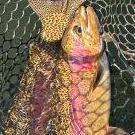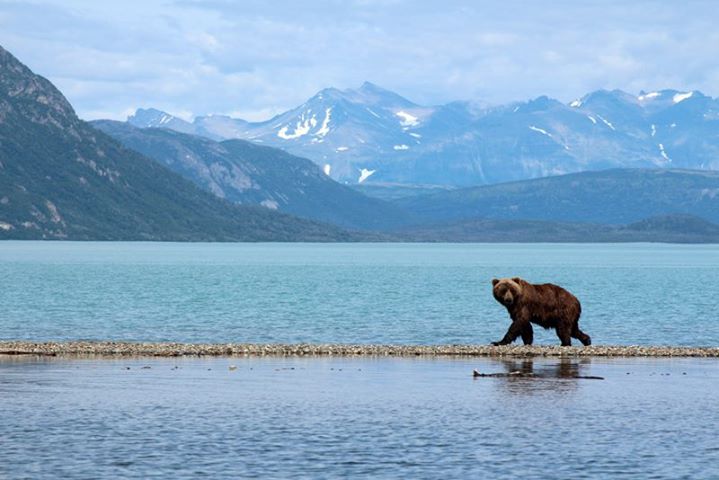-
Posts
18,931 -
Joined
-
Last visited
-
Days Won
123
Content Type
Profiles
Forums
Blogs
Events
Articles
Video Feed
Gallery
Everything posted by Phil Lilley
-
I believe the stocking numbers for each month were off because low water conditions messed up when trout were ready to be released- proper size and all. I think there were less numbers of rainbows stocked in the summer months and more in the winter. This month I know we got alot more than we were supposed to, but Chris Vitello said we would get the 700,000 rainbows we were supposed to for the year. Thanks my guess. This survey was taken the last of August and is taken that time of year each year. They did say that most of the time there's generation on the day they take it and they always are able to boat up past the MDC boat ramp to shock fish. But this year they did not generate and the water wasn't high enough to get their shock boat past the ramp- so that skewed the numbers on big fish above Fall Creek- that makes sense. But I still believe we had less trout and smaller trout above FC than in any year since '97- guides agree. Survey agrees. Browns- again, if they have an early migration, the numbers can change. But I think there are more and bigger browns this year than last... so I think the survey is correct.
-
http://ozarkanglers.com/taneycomo/2006_survey.php
-
It's frozen once over night back in the 80's but when the water started the next morning it broke up. Very, very seldom.
-
I guess- it's the same water. Maybe a bit different temp. Mike Kruse always told me it was the water temp, not generation.
-
http://www.ozarkflyfishers.org/pages/newsl...2/nl_y06m12.pdf
-
Heard a story about someone catching crappie in pole timber on bluff banks 5-15 ft deep the last week. Minnows and jigs. Getting this 3rd hand- have no time to try it myself. If you go, give us a report.
-
We only have a few reservations this weekend. I don't like to see rooms go unused. For this weekend only and any days between now and December 21, 2006 - Singles - $19 per night 2 bedrooms off lake - $29 per night Lake front 2-3-4 bedrooms - 60% off regular rate... http://lilleyslanding.com/rooms.php for rates 2 night minimum please on any reservations Stalls free Boat Rental 50% off, gas not included Call 1-800-284-2196 for reservations.
-
If you're wading, generation almost kills fishing for you. Depending on how much water is running, you can fish around the outlets or along some banks but it's difficult at best. Get a boat for best fishing results.
-
If you don't want to wade around crowds, go down to Rocking Chair or the boat ramp- from the boat ramp wade up or downstream to KOA. There's usually not as many people down there. But there's no reason not to walk in around the outlets and see what the crowds look like up there. Sometimes there's not that many people, esp in the middle of the day or evenings.
-
20 inch... sending you an email.
-
Browns on the White successfully spawn and replentish the river. Brown do not successfully spawn in Taneycomo so there's no reason to protect the spawn season. Rainbows spawn in Taneycomo mainly in January and February but some spawn as late as May. When rainbows are raised in a hatchery, their biological time clocks are screwed up because the way they are raise. They are raised in varied water temps to stunt growth or to speed growth, depending on when they are sceduled to be released. So they really don't know when to spawn... but most do in the winter. Why? Not sure. The White- I honestly don't know. I'll let someone else answer that.
-
http://ozarkanglers.com/troutcam.php I turned the camera to the north out away from the building and am picking up alot more light. The water isn't as clear and as the lake turns, the water will become even more silty. But for now, there's a few trout- one big brown and a few chubs swimming around. OK- as I sit here looking, I see a sucker and a blue gill... so there's more varieties than I though.
-
Jim and I are now booking "fish-on-your-own" trips and have openings for up to 3 people each week in the months of July and August. $1395 per person pays for one cabin that will sleep 2-3 people, a use of one boat for the week (7 night stay Saturday to Saturday) and all meals. Does not include flights, license or a guide but we will try to do as much as we can to put you on fish while you're there. This is possbile because I am moving an old cabin and renovating it in May so when I'm not there, we will rent it for fish-on-your-own clients.
-
How about a fishing report from your trip??? Any big fish pics?
-
The hatchery personnel like the DO in water entering the raceways to be 11 ppm and the water leaving the raceways into the lake to be 9 ppm. This is achieved by running the water thru aeriation stacks at the head of each raceway. An oxygen injection system is being installed in the new addition and I think in the old raceways as well (not sure) but the addition will help the hatchery achieve this goal. I was also told that #3 and #4 outlets will reopen when the raceways are done BUT my thinking that #3's flow would increase was wrong. they are actually going to redirect the water from the new raceways up to #1 and #2 and increase flow a bit, lessening the flow from #3 and #4. Why? In the fall, #1 and #2 outlets keep the upper lake alive and lessening the flow would only hurt the fishery. But in the fall when they need browns to move up in #3, up the ladder they're building into the spawning house, they will increase #3's flow to accommodate the run. Shepherd wants to create a youth/handicap fishery there east of the new expansion in the way of a short stream and pond at the base of the stream. #4 would be the pipe that now exist about 200 yds below #3 oulet. But this plan is not yet funded.
-
Glad you got out Jeff... even though it was COLD! And glad the fish cooperated.
-
Emailed James Friday- I honestly thought with the very cold temps the lake would show signs of moving... hasn't happened. He said there's no movement. He thought it would turn by Christmas. With the warm temps forecasted for all this week, nothing will happen. it's got to get colder and stay cold and it'll turn.
-
Looking for a long shaft used motor, 15-25 hp, but I need to find one in the next 3 days. Long shot I know but worth trying. Thanks Phil
-
Go to Alaska! You'll never come back!! And I didn't write the article... only posted it. Thanks for the comments though.
-
How are you fishing your egg flies? Water running? Are you in a boat or wading?
-
Jim Johnson (Michigan & Alaska), his sone James and I drove to the dam this afternoon and tried our hand at some fishing. Started above #2 in the skinny water and caught a few small rainbows on a #22 red thread midge. Jim tried a #22 adams- no luck. James used a #20 trout crack light and caught a couple. We were all using 7x. Lots of people at outlet #2- a few above us and a few below #2. I was surprised there was no few people on a beautiful Saturday afternoon. We headed down below #2 and found some good trout cruising the bank. I tied on a #20 dark trout crack and lured a nice brown to take but the hook pulled out after a 3 minute fight. It was pushing 24 inches- male. Went on down below rebar and fished the narrows there. James hooked a few and so did I. Jim struggled but finally got into a few rainbows- no one hooked anything big. We finished at rebar where I hooked another nice trout but again the hook pulled out. I never saw it. Both Jim and James hooked nice rainbows on #18 dark scuds- Jim did try a bead/egg and hooked a nice brown which broke him off. I saw more dark male rainbows than ever. Saw some trophy rainbows below #2 and in the rebar. John Johnson from Kingfisher, OK is here with his crew of friends fishing from boat from Lookout to Fall Creek. John said they did real good the last 2 mornings early before they shut the water off drifting from the dam to the MDC boat ramp drifting both scuds and egg flies on the bottom. He said he caught one 18 inch brown today the dropped a ton of eggs in his boat before he could release it. They've caught some rainbows in the 15 inch range but most are stockers 10-11 inch. After the water shuts down they're fishing zebras and scuds and doing pretty good.
-
http://ozarkanglers.com/fff/nafff-12-06_newsletter.pdf
-
Sorry- the image isn't there anymore. Check it out. If you used a service to upload and post pics, your subscription has laps. Says something about linking remote images or something. Send me the original and I'll post it for you. pl
-

Horns, Water Generation and a Fast River
Phil Lilley replied to LostMyWife's topic in Upper Lake Taneycomo
I've heard that the horn is activated by air entering a turbine... and one horn equals one turbine... but I've never had those stories confirmed. But the number of horns could every well indicate how much water will run. BUT if the horn blows once, I'd heed the warning and move to safe ground. The amount of water released varies from very little, delayed to alot and all at once. You never know, and you should assume to know. One thing though, always move downstream if you get in trouble, if possible. If you watch the release, you'll see the flow moving down- on the rise. On the White River, the rise is more dramatic but moves downstream slower it seems. You can actually outrun it if you are able to. But I am not an expert by any means on the White... only a few experiences under my belt. -
You know Solomon asked for only one thing - wisdom. He's known as the richest man who ever lived.


